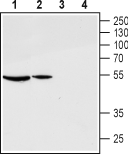Overview
- Peptide (C)NNASLEQDQNH, corresponding to amino acid residues 3-13 of rat GnRHR (Accession P30969). Extracellular, N-terminus.

 Western blot analysis of rat ovary (lanes 1 and 3) and pituitary (lanes 2 and 4) lysates:1,2. Anti-GnRH Receptor (extracellular) Antibody (#AGR-030), (1:200).
Western blot analysis of rat ovary (lanes 1 and 3) and pituitary (lanes 2 and 4) lysates:1,2. Anti-GnRH Receptor (extracellular) Antibody (#AGR-030), (1:200).
3,4. Anti-GnRH Receptor (extracellular) Antibody, preincubated with GnRH Receptor (extracellular) Blocking Peptide (#BLP-GR030).
 Expression of GnRHR in rat ovaryImmunohistochemical staining of rat ovary paraffin-embedded sections using Anti-GnRH Receptor (extracellular) Antibody (#AGR-030). GnRHR labeling appears in the stroma surrounding the follicles. The stroma is a richly cellular connective tissue with scattered smooth muscle fibers. The theca layer is stained as well. Hematoxilin is used as the counterstain.
Expression of GnRHR in rat ovaryImmunohistochemical staining of rat ovary paraffin-embedded sections using Anti-GnRH Receptor (extracellular) Antibody (#AGR-030). GnRHR labeling appears in the stroma surrounding the follicles. The stroma is a richly cellular connective tissue with scattered smooth muscle fibers. The theca layer is stained as well. Hematoxilin is used as the counterstain.
- Naor, Z. (2009) Front. Neuroendocrinol. 30, 10.
- Millar, R.P. et al. (2004) Endocr. Rev. 25, 235.
- Tello, J.A. et al. (2005) Endocrinology 146, 4061.
- Bliss, S.P. et al. (2010) Front. Neuroencrinol. 31, 322.
- Cheung, L.W. and Wong, A.S. (2008) FEBS J. 275, 5479.
Gonadotropin-releasing hormone (GnRH) or Luteinizing hormone releasing hormone (LHRH) is a decapeptide synthesized and released from neurons in the hypothalamus and stimulates the synthesis and release of gonadotropin hormone (or luteinizing hormone) and follicle stimulating hormone from the pituitary gland1. GnRH is expressed as various variants, and most vertebrates express more than one form of GnRH1-3.
GnRH and its variants bind and activate GnRH receptor (GnRHR), a member of the G-protein coupled receptor (GPCR) superfamily. Three forms of the receptor have been identified in vertebrates (types I, II and III). Like all members, GnRHR has seven transmembrane domains and an extracellular N-terminus and an intracellular C-terminal tail. The receptor also has a number of glycosylation sites in its extracellular loops. In addition, the C-terminal tail is unusually short and lacks consensus sites known to undergo post-translational modifications like phosphorylation. In consequence, this affects the receptor’s desensitization and internalization4.
Expression of GnRHR is detected in the gonadotrope and various tissues like the breast, gonads, prostate and uterus4,5.
Application key:
Species reactivity key:
Anti-GnRH Receptor (extracellular) Antibody (#AGR-030) is a highly specific antibody directed against an epitope of rat GnRHR. The antibody can be used in western blot and immunohistochemistry applications. The antibody recognizes an extracellular epitope, and can potentially be used for detecting the protein in living cells. It has been designed to recognize GnRHR from mouse and rat samples. It is not suited to recognize GnRHR from human samples.

